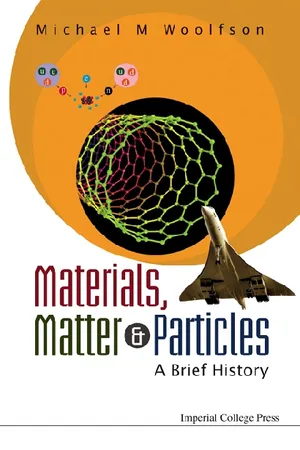
- 328 pages
- English
- PDF
- Available on iOS & Android
About this book
This book traces the history of ideas about the nature of matter and also the way that mankind has used material resources that the world offers. Starting with the ideas of ancient civilizations that air, earth, fire and water were the basic ingredients of all matter, it traces the development of the science of chemistry beginning within the ranks of the alchemists. First, the idea of elements grew and then the atomic nature of matter was verified. Physicists had entered the scene, showing the nature of atoms in terms of fundamental particles and then introducing the concept of wave-particle duality that altered the basic concepts of what matter was. Finally the physicists discovered a panoply of fundamental particles, some observed within atom-smashing machines and the existence of others merely postulated.In parallel with the above there is a description of various kinds of matter as it affects everyday life — including the nature of matter associated with life itself. The way that early man used the materials directly given by nature, such as stone, wood and animal skins, is followed by the use of materials requiring some process to be employed — e.g. metals which include bronze and also concrete. Some important modern materials are discussed, such as synthetic fibres and plastics and semiconductors, and potentially important future products from new developments in nanotechnology.
Frequently asked questions
- Essential is ideal for learners and professionals who enjoy exploring a wide range of subjects. Access the Essential Library with 800,000+ trusted titles and best-sellers across business, personal growth, and the humanities. Includes unlimited reading time and Standard Read Aloud voice.
- Complete: Perfect for advanced learners and researchers needing full, unrestricted access. Unlock 1.4M+ books across hundreds of subjects, including academic and specialized titles. The Complete Plan also includes advanced features like Premium Read Aloud and Research Assistant.
Please note we cannot support devices running on iOS 13 and Android 7 or earlier. Learn more about using the app.
Information
Table of contents
- Contents
- Introduction
- Chapter 1 The Elements of Nature
- Chapter 2 Early Ideas of the Nature of Matter
- Chapter 3 The Quest for Gold and Eternal Life
- Chapter 4 The Beginning of Chemistry
- Chapter 5 Modern Chemistry is Born
- Chapter 6 Nineteenth Century Chemistry
- Chapter 7 Atoms Have Structure
- Chapter 8 Radioactivity and the Plum-Pudding Model
- Chapter 9 Some Early 20th Century Physics
- Chapter 10 What is a Nucleus Made Of ?
- Chapter 11 Electrons in Atoms
- Chapter 12 The New Mechanics
- Chapter 13 Electrons and Chemistry
- Chapter 14 Electron Spin and the Exclusion Principle
- 15 Isotopes
- Chapter 16 Radioactivity and More Particles
- Chapter 17 Making Atoms, Explosions and Power
- Chapter 18 Observing Matter on a Small Scale
- Chapter 19 Living Matter
- Chapter 20 Life at the Atomic Level
- Chapter 21 Materials from Ancient Times
- Chapter 22 Modern Materials
- Chapter 23 The Fantastic World of Particles
- Chapter 24 How Matter Began
- Chapter 25 Making Heavier Elements
- Index